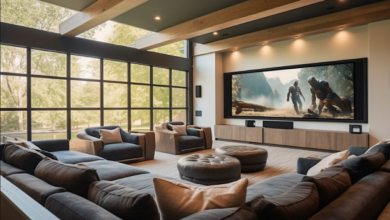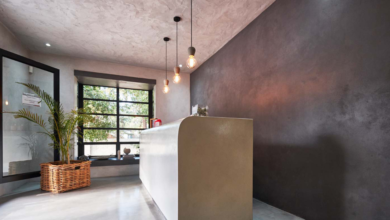Top Trends in Commercial Painting Techniques and Materials

Step into a world where colors come alive and spaces are transformed with the stroke of a brush. Commercial painting is more than just adding a coat of paint – it’s an art form that shapes environments, enhances aesthetics, and conveys brand identity. In this blog post, we delve into the top trends in commercial painting techniques and materials that are revolutionizing the industry. From advancements in paint technology to innovative design concepts, discover how the world of commercial painting is evolving to meet the demands of modern businesses.
Advancements in Paint Technology
Advancements in paint technology have revolutionized the commercial painting industry, offering more durable and long-lasting solutions. New formulations now provide improved resistance to weathering, fading, and cracking, ensuring a fresh look for years to come.
Innovative paint additives contribute to enhanced performance characteristics such as mold and mildew resistance, making maintenance easier for commercial spaces. Additionally, anti-microbial paints are gaining popularity for their ability to inhibit the growth of bacteria on painted surfaces.
Low-VOC (volatile organic compounds) paints have become standard due to their reduced environmental impact and improved indoor air quality. This shift towards eco-friendly options aligns with the growing demand for sustainable practices in commercial painting projects.
The development of self-cleaning paints incorporating nanotechnology is another exciting advancement. These coatings create a hydrophobic surface that repels dirt and grime, reducing the need for frequent cleaning and maintenance.
The Rise of Eco-Friendly and Sustainable Paints
As awareness of environmental issues grows, the demand for eco-friendly and sustainable paints has been on the rise in the commercial painting industry. These innovative paints are formulated with low or zero volatile organic compounds (VOCs), reducing harmful emissions that can affect indoor air quality.
Many commercial painters are now opting for water-based paints that have minimal impact on both human health and the environment. Companies specializing in sustainable paint solutions are constantly developing new formulas using natural ingredients like plant oils, minerals, and even recycled materials.
Not only do these eco-friendly paints contribute to a healthier workspace, but they also offer high-quality finishes and durability comparable to traditional paint products. Additionally, some sustainable paints come in a variety of trendy colors and finishes, allowing businesses to maintain aesthetic appeal while being environmentally conscious.
Incorporating eco-friendly paints into commercial painting projects not only benefits the environment but also aligns with corporate social responsibility initiatives. By choosing sustainable options, businesses can showcase their commitment to sustainability while creating vibrant workspaces for employees and clients alike.
Innovative Techniques for Commercial Painting
When it comes to commercial painting, innovative techniques are revolutionizing the industry. One of these cutting-edge methods is spray painting, which allows for faster and more even coverage compared to traditional brushes or rollers. This technique not only saves time but also ensures a flawless finish.
Another innovative approach is electrostatic painting, where paint particles are charged and attracted to the metal surface being painted. This results in minimal overspray and maximizes paint adhesion for a durable coat that lasts longer.
Furthermore, some companies are embracing digital technology by using virtual reality simulations to plan out complex painting projects. By visualizing the final result beforehand, painters can work with greater efficiency and accuracy.
These innovative techniques are changing the game in commercial painting, providing businesses with high-quality finishes in less time than ever before.
Utilizing Technology for Efficiency and Precision
Technology has revolutionized the commercial painting industry, offering innovative solutions to enhance efficiency and precision. With the use of advanced tools such as digital color matching systems, painters can now accurately replicate colors with ease. Additionally, software applications enable professionals to create detailed project plans and track progress in real-time.
Robotic painting systems have also emerged as a game-changer, providing consistent and flawless finishes on large-scale projects. These machines are programmed to apply paint evenly and quickly, saving time and reducing errors. Furthermore, drones equipped with high-resolution cameras are utilized for aerial inspections, allowing painters to assess hard-to-reach areas without compromising safety.
The integration of technology not only streamlines processes but also ensures a higher level of quality control throughout the painting project. As technology continues to evolve, we can expect further advancements that will shape the future of commercial painting industry.
Emerging Trends in Color and Design
When it comes to commercial painting, staying up-to-date with the latest color and design trends can make a significant impact on the overall aesthetic appeal of a space. One emerging trend in the commercial painting industry is the use of bold and vibrant colors to create visually striking interiors. These eye-catching hues can help businesses stand out and leave a lasting impression on clients and customers.
Another popular trend is incorporating modern design elements such as geometric patterns or abstract motifs into commercial spaces. This innovative approach adds depth and character to walls, transforming them from plain surfaces into works of art. Additionally, there is a growing interest in using sustainable materials for paint finishes, aligning with eco-conscious values while still achieving stunning results.
Mixing different textures like matte finishes with glossy accents has also become increasingly popular in commercial painting projects. This technique adds dimension and visual interest to walls, creating dynamic focal points within a space. Embracing these emerging trends in color and design allows businesses to showcase their unique brand identity through creative expression in their physical environment.
Conclusion: The Future of Commercial Painting
As we look ahead, the future of commercial painting is filled with exciting possibilities. With advancements in paint technology, the rise of eco-friendly and sustainable paints, innovative techniques for efficiency and precision, and emerging trends in color and design, the commercial painting industry is evolving to meet the demands of modern businesses.
By embracing new technologies and materials while staying true to quality craftsmanship, commercial painters can expect to see continued growth and success in their field. The key lies in adaptation, creativity, and a commitment to delivering exceptional results that not only beautify spaces but also contribute to a healthier environment.
In this ever-changing landscape of commercial painting, one thing remains constant – the importance of staying informed about the latest trends and techniques. By keeping up with industry developments and continuously refining skills, commercial painters can position themselves as leaders in their field well into the future.
The journey towards excellence in commercial painting is ongoing – let’s embrace these changes together as we shape the future of this dynamic industry.



